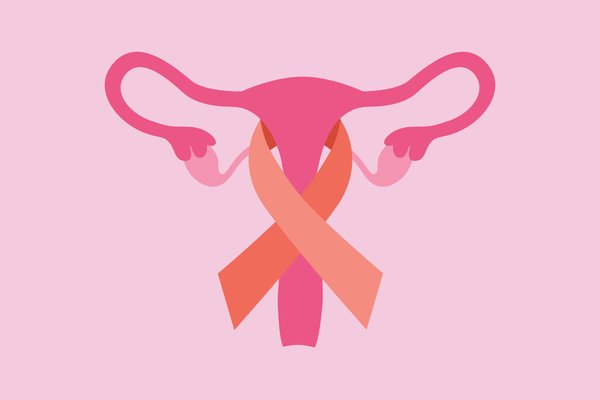Hormones, which are chemicals in your body, act like messengers to help control your cells and organs. And endocrine disruptors are chemicals that interfere with the way hormones work.
Some endocrine disruptors occur naturally and others are made by humans. The Endocrine Society estimates that there are nearly 85,000 human-made chemicals in the world — and 1,000 or more of them may be endocrine disruptors.
Endocrine disruptors can block normal hormonal functions or mimic them so that they “trick” the body to overproduce or underproduce the hormones it needs to function normally.
These chemicals are thought to be linked to several developmental or biological issues, including endometrial cancer.
The link between endocrine disruptors and endometrial cancer
Endometrial cancer, which grows in the lining of the uterus, is the most common cancer that affects women’s reproductive systems. And some types of endometrial cancers are driven by estrogen.
“Recent research has shown that endocrine disruptors appear to be associated with endometrial cancer in women by increasing the amount of estrogen in their bodies,” said Dana M. Chase, M.D., a gynecologic oncologist at UCLA Health.
Exposure to estrogen can cause the endometrial lining to grow too much and eventually turn cancerous.
Endocrine disruptors are everywhere
Many research studies have shown that we all have contact with endocrine disruptors in multiple ways, including through the:
- Air we breathe
- Food we eat
- Water we drink
- Things we touch
Endocrine disruptors are found in many everyday products. Common types of endocrine disruptors and where they’re used include:
BPA - Used to help manufacture plastic products like shatter-proof windows, eyewear, water bottles; also coatings that line some metal cans and bottle tops.
Dioxins - Released into the air during wildfires, backyard fires and industrial processes like herbicide manufacturing and paper bleaching. Most exposure comes from eating animal fats in meat, dairy products and fish.
PFAs - These coatings are used to make cookware non-stick and clothing stain-resistant and waterproof.
Phthalates - Known as “plasticizers,” these compounds make cosmetics, fragrances, nail polishes, hair sprays, aftershave lotions, cleansers and shampoos last longer.
PCBs - Banned in the United States since 1979, products made before the ban may still contain PCBs, including electrical equipment, oil-based paint, plastics, adhesives and caulking.
Triclosan - Used to prevent bacterial contamination in products like antibacterial soaps, body washes and toothpastes.Phytoestrogens can also be endocrine disruptors
Phytoestrogens are naturally occurring estrogens from plants that we eat. They are considered endocrine disruptors because they may have a similar effect as estrogen produced by the body. Therefore, phytoestrogens can upset the balance between estrogen and progesterone by acting on the endometrial lining.
However, the effect of phytoestrogens on the body has not been determined. It was once thought that phytoestrogens might contribute to certain cancers. However, research has indicated that there is no increased risk if you get your phytoestrogens from naturally occurring plant sources rather than from synthetic sources.
In fact, plant-based phytoestrogens may even have protective benefits against certain conditions, like osteoporosis, heart disease, breast cancer, endometrial cancer and vasomotor symptoms of menopause.
Foods that may contain phytoestrogens include:
- Soy products like tofu and soy milk
- Peanuts and peanut butter
- Flax seed
- Peas
- Beans
- Beer
Avoiding endocrine disruptors
Because endocrine disruptors are literally everywhere, there’s no way to remove them from your environment or avoid them completely.
However, the Endocrine Society suggests simple steps to reduce your family’s exposure:
- Drink filtered — not bottled — water.
- Minimize consumption of processed foods as much as possible.
- Don’t store canned foods in areas where excessive heat can cause endocrine disruptors to leach into the can’s contents.
- Reduce pesticide use in your home and yard.
The alphabet soup of endocrine disruptors
A 2022 review article examined possible connections between endometrial cancer and endocrine disruptors, including bisphenol A (BPA), polychlorinated biphenyls (PCBs) and polycyclic aromatic hydrocarbons (PAHs).
The authors concluded that links exist between these chemicals and endometrial cancer on a molecular level. However, it is not currently possible to know how much exposure individual people are getting to these chemicals and what amount is dangerous.
More recently, a different group of researchers compared the total estrogen load in the blood of more than 300 women. Approximately half the women had endometrial cancer and half did not. The researchers were able to determine how much estrogen each woman’s body made versus estrogen that came from several types of endocrine disruptors.
Women who had higher estrogen levels from endocrine disruptors were more likely to have endometrial cancer than those with the lowest levels. This study has identified, for the first time, a positive association between estrogen levels from outside the body and endometrial cancer risk.
These conclusions are what Chase expected, at least for now. “Correlation is not causation so, at this point, the link between endocrine disruptors and endometrial cancer is just an interesting association,” she said. “We do know that excess estrogen in the body puts women at risk for endometrial cancer and that we have products in our environment that alter the amount of estrogen in our bodies. But it’s important for people to understand that they won’t avoid endometrial cancer just because they stop drinking out of plastic bottles. It’s not that simple.”
This educational resource was created with support from Merck.





